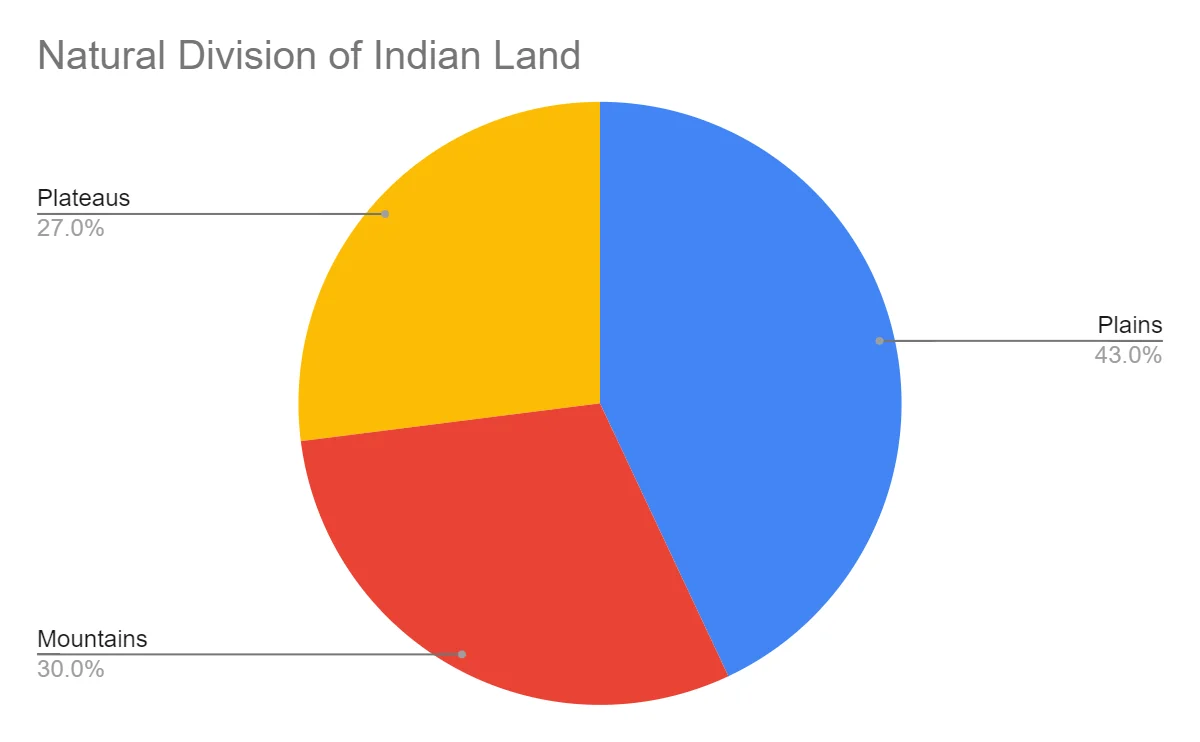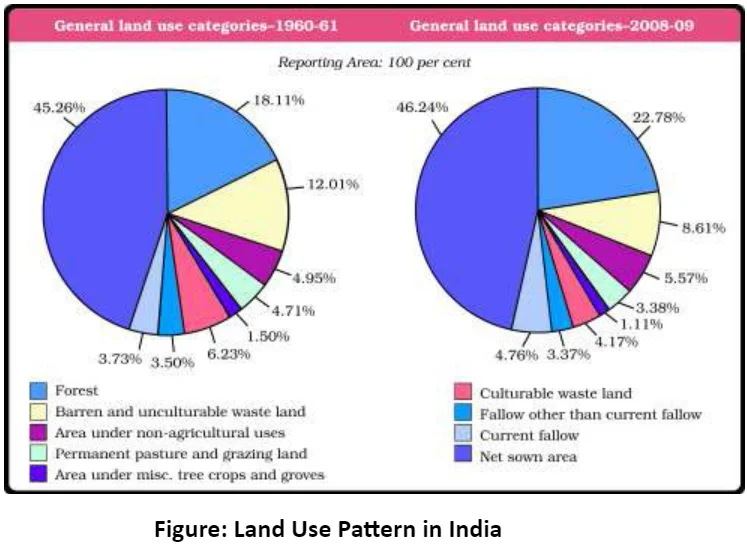India, with its significant population and livestock, manages its land resources through various categories like forests, non-agricultural uses, and grazing lands. These categories are overseen by different government departments to ensure effective land management. Despite having more arable land and irrigation than China, India’s agricultural productivity per hectare lags behind.
Overview of Land Resources and Usage Patterns in India: Challenges and Trends
- Land Resources: Land is a vital natural resource for human activities and supports various aspects of life including natural vegetation, wildlife, and economic endeavors.

-
- India’s diverse relief features include mountains, plateaus, plains, and islands, each serving different purposes.
- Plains: Approximately 43% of India’s land is flat plains,
- These plains are ideal for agriculture and industrial development.
- Mountains: cover around 30% of the country’s surface area,
- It ensures perennial river flow, supports tourism, and contributes to ecological balance.
- Plateaus: Constituting about 27% of India’s land area,
- It holds abundant reserves of minerals, fossil fuels, and forests, contributing significantly to the country’s resource wealth.
Land Use Categories
- India holds about 18% of world population and the largest livestock population on 2.5 % of land area.
- Land Use Records: These are maintained by the Land Revenue Department.
- Survey of India is responsible for measuring the geographical area of administrative units of India.
- Forests: Areas demarcated for forest growth, which may not necessarily represent actual forest cover.
- Land put to Non-agricultural Uses: Land under settlements (rural and urban), infrastructure (roads, canals, etc.), industries, etc. An expansion in the secondary and tertiary activities would lead to an increase in this category of land- use.
- Barren and Wastelands: Land such as barren hilly terrains, desert lands, ravines, etc.; normally cannot be brought under cultivation with the available technology.

- Area under Permanent Pastures and Grazing Lands: Most of this type of land is owned by the village ‘Panchayat’, mostly as ‘common property resource’, or by the Government. Only a small proportion of this land is privately owned.
- Area under Miscellaneous Tree Crops and Groves (Not included is Net sown Area): Land under orchards and fruit trees. Much of this land is privately owned.
- Culturable Waste-Land: Land which is left fallow (uncultivated) for more than five years. It can be reclaimed for cultivation.
- Current Fallow: Land left uncultivated for one agricultural year or less, allowing it to regain fertility naturally.
- Fallow other than Current Fallow: Cultivable land left uncultivated for more than a year but less than five years.
- Net Area Sown: Land on which crops are sown and harvested.
| India has more arable area and land under irrigation as compared to China but the productivity per hectare of Indian agriculture is lower than that of China. (UPSC 2023) |
Land Use Changes in India
- Factors Affecting Land Use Change
- Land use is shaped by economic activities, but while these activities change, land remains fixed.
- Economic growth, driven by factors like population increase and technological advancements, intensifies pressure on land, bringing marginal lands into use.
- Economic composition shifts over time, with secondary and tertiary sectors growing faster than agriculture, leading to a shift from agricultural to non-agricultural land use, especially evident near urban areas.
- Pressure on Agricultural Land: Despite declining contribution of agriculture to GDP, pressure on agricultural land persists due to slow population decline in the agricultural sector and increasing food demand.
- Land Use Trends in India: India’s economy has evolved over the past decades, influencing land use changes.
- Increases: Four areas have shown an increased trend. It has been observed in forest areas, non-agricultural use, current fallow lands, and net area sown, primarily due to economic restructuring and agricultural land conversion.
- Decreases: Barren and wasteland, culturable wasteland, areas under pastures and tree crops, and fallow lands have shown declining trends.
- Factors: Increased pressure on land from both agricultural and non-agricultural sectors contributes to decline in wastelands and culturable wastelands.
- Reduction in land under pastures and grazing lands is attributed to encroachment for cultivation, particularly on common pasture lands.
Agricultural Land Use in India
- Significance of Agriculture: Agriculture depends heavily on land compared to other sectors like manufacturing or services.
- The quality of land directly affects how productive agriculture can be.
- Significance of Land Ownership: Having access to land is crucial for rural people to escape poverty.
- Land ownership in rural areas not only helps with farming but also provides security for things like loans, natural disasters, and social status.
- Calculation of Total Agricultural Land: Estimating the total agricultural land available can be calculated by adding the net sown area, all fallow lands and culturable wasteland.
- Declining Trend: It has been observed that There has been a small decrease in the total amount of land available for farming, even though the amount of land left uncultivated has also decreased.
Operational Land Holding In India
-
- Average Size: The average size of operational holdings has declined to 1.08 ha in 2015-16 as compared to 1.15 in 2010-11 as per Agri Census 2015-16.
-
- The total number of operational holdings has increased and the total operated area has decreased since 2010-11.
- The percentage share of female operational holders has increased to 13.96% in 2015-16 with 11.72% in the operated area.
- Marginal (0-1 ha.) and Small (1-2 ha.) holdings taken together constituted 86.08% of the total holdings in 2015-16 while their share in the operated area stood at 46.94%. Both have increased since 2010-11.
- Semi-medium (2-4 ha.) and Medium (4-10 ha.) operational holdings in 2015-16 were only 13.35% with 43.99% operated area. Both have decreased since 2010-11.
- Large holdings (10.00 ha. & above) were 0.57% of the total number of holdings in 2015-16 and had a share of 9.07% in the operated area. Both have decreased since 2010-11.
Conclusion
- India’s land resources and usage patterns reflect a delicate balance between economic growth, environmental sustainability, and social equity.
- While there have been notable increases in certain land use categories like forests and non-agricultural uses, declines in others underscore the need for careful land management policies.
- Understanding these trends is essential for fostering sustainable development and ensuring the well-being of both rural and urban communities in India.
![]() May 2, 2024
May 2, 2024
![]() 11794
11794
![]() 0
0

